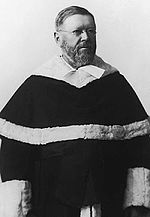John Idington (original) (raw)
From Wikipedia, the free encyclopedia
| John Idington | |
|---|---|
 John Idington in 1914 John Idington in 1914 |
|
| Puisne Justice of the Supreme Court of Canada | |
| In officeFebruary 10, 1905 – March 31, 1927 | |
| Nominated by | Wilfrid Laurier |
| Preceded by | Albert Killam |
| Succeeded by | John Lamont |
| Personal details | |
| Born | (1840-10-14)October 14, 1840Puslinch, Upper Canada |
| Died | February 7, 1928(1928-02-07) (aged 87)Ottawa, Ontario |
| Resting place | Avondale Cemetery, Stratford |
| Spouse | Margaret Colcleugh |
| Children | 11 |
| Alma mater | University of Toronto |
| Profession | Lawyer |
John Idington (October 14, 1840 – February 7, 1928) was a Canadian justice of the Supreme Court of Canada.
Born in Puslinch, Upper Canada (now Ontario), the son of Peter Idington and Catherine Stewart, he received his LL.B degree from the University of Toronto and was called to the Ontario Bar, both in 1864. He practised law in Stratford, Canada West (now Ontario) for forty years.
He was created a provincial QC in 1876 and a dominion QC in 1885.
In 1904, he was appointed to the High Court of Justice of Ontario and he was appointed by Wilfrid Laurier to the Supreme Court on February 10, 1905. In 1924, following the death of Sir Louis Henry Davies, Idington was passed over for the position of Chief Justice of Canada, even though he was the senior Pusine Justice on the Court.
His notable decisions include his dissent in Quong Wing v. R.,[1] in which he disagreed with the effects of racist legislation, on the basis that the use of the term "Chinaman" could not have been meant to refer to naturalized Canadians of Chinese origin.
He retired on March 31, 1927, at age 86, after legislation was passed requiring a mandatory retirement age of 75.[2]
A believer in the need for proportional representation, in 1898 he was chairman of the Proportional Representation Committee of Ontario.[3][1]
- ^ (1914), 49 S.C.R. 44
- ^ An Act to amend the Supreme Court Act, S.C. 1927, c. 38, s. 2.
- ^ Proportional Representation Committee of Ontario (1898). Effective Voting - the Basis of Good Municipal Government. p. 30.
- Works by or about John Idington at the Internet Archive
- Supreme Court of Canada biography
- "John Idington". Dictionary of Canadian Biography (online ed.). University of Toronto Press. 1979–2016.